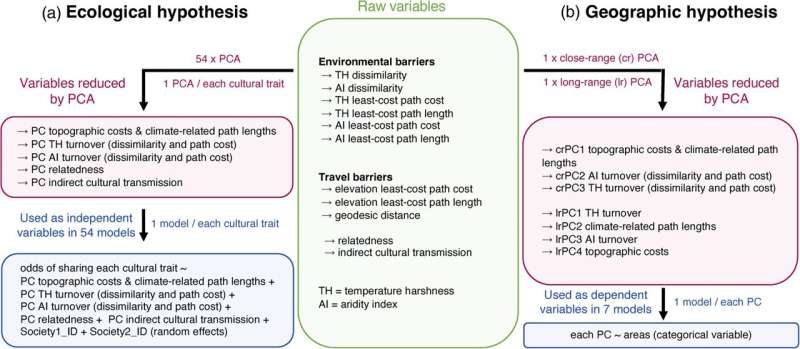This article has been reviewed according to Science X's editorial process and policies. Editors have highlighted the following attributes while ensuring the content's credibility:
fact-checked
trusted source
proofread
Did Eurasia's dominant East-West axis 'turn the fortunes of history'?

Guns, Germs, and Steel (1997) is Jared Diamond's Pulitzer Prize-winning effort to explain the contrasting histories of Native Americans, Africans, and aboriginal Australians vs. Europeans and Asians. One of his intriguing proposals was that Eurasian political and military dominance could be partially explained by its unique continental orientation.
Eurasia's unique dominant East-West axis could have enabled a rapid spread of domestication practices, writing systems, the wheel, and other key cultural innovations and could have thus put Eurasia on track for faster development than Africa or the Americas. In Diamond's words, "Geography may have 'turned the fortunes of history'." The axis of orientation hypothesis was met with both abundant enthusiasm and harsh criticism, but quantitative tests of this important claim have been scarce.
In a new study, an interdisciplinary team of researchers from Washington University in St Louis and the Max Planck Institute for Evolutionary Anthropology in Leipzig leveraged a comprehensive data set on global differences in culture, languages, and ecology to test Diamond's hypothesis.
The study's first author, Angela Chira, from the Max Planck Institute for Evolutionary Anthropology, explained, "Our first challenge was to translate what Diamond envisioned into numbers. We used least-cost path algorithms to find the paths that minimized differences in temperature and aridity regimes between societies. The length and cost of these paths give us the magnitude of ecological barriers to cultural transmission between two societies, precisely as Diamond envisioned them."
The team quantified the potential for environmental parameters associated with latitude to influence the ease of transmission for 54 traits covering diverse aspects of cultural and social life (subsistence, housing ecology, property rules, marriage and kinship, community organization, politics, labor, and rituals).
In line with Diamond's thinking, the team found that environmental factors and topographic and travel costs hinder the spread of a wide array of cultural traits, including some that directly relate to social development (e.g., dominant mode of subsistence, domestic animal type, political complexity traits). However, their findings showed that contrary to Diamond's expectations, Eurasia is about as ecologically heterogeneous as other regions of our world.
Environmental barriers to cultural transmission are not weaker in Eurasia.
The team then computed environmental barriers to cultural transmission out of 16 key areas: the centers where agriculture originated. They found that the magnitude of environmental barriers can vary substantially within the same continent. As Diamond intuited, geographic mechanisms were significant in some areas, but the continent's dominant axis did not uniformly dictate the potential for cultural spread.
Environmental heterogeneity along Eurasia's major corridors of cultural transmission was not significantly lower than observed in other continents. One of the authors, Russell Gray from the Max Planck Institute for Evolutionary Anthropology, summarizes the results by saying, "Our findings point out that geography, like genetics and ecology, matters, but it is not destiny."
Senior author of the study, Carlos Botero from the University of Texas at Austin, concludes with a word of caution, "We do not claim, by any means, to have a definitive answer on whether the wheels of history turned at different speeds in different parts of the world."
"What we aim instead is to provide a new perspective based on quantitative data and thorough analyses, and a blueprint on how the tools and data we already have can be leveraged to test compelling ideas that have strongly shaped the public's understanding of our own past."
The work is published in the journal Evolutionary Human Sciences.
More information: Angela M. Chira et al, Geography is not destiny: A quantitative test of Diamond's axis of orientation hypothesis, Evolutionary Human Sciences (2024). DOI: 10.1017/ehs.2023.34
Provided by Max Planck Society



















